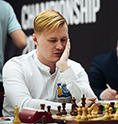8 June 2015
Dissention and Confusion
Round Eight Review of the Final FIDE Grand Prix in Khanty-Mansiysk by GM Sergei Shipov.
I must admit that I have been expecting anything but such a dynamic finish of the second quartet of games. Instead of settling for some tenacious risk-free play, the opponents went straight into an open hand-to-hand combat. This led to the greatest number of decisive games in a single round of the tournament.
One quite excusable exception happened in the game between Vachier-Lagrave and Giri. Maxime needed to put an end to his truckload of non-stop defeats and thus deliberately opted for a known drawish continuation in the Anti-Meran Variation.
Meanwhile other games saw their players being engaged in a fierce fighting...
I must confess that by now I start to feel somewhat exhausted to be able to continue analyzing all the games in much detail (and I am willing to break my own records on the number of concurring online and after-game reviews some other time around). As ill luck would have it, this round proved exceptionally rich in chess content. I am just going to touch upon the most dramatic moments in the encounters.
The tournament leader was unseated... of his own free will!
Caruana - Jakovenko
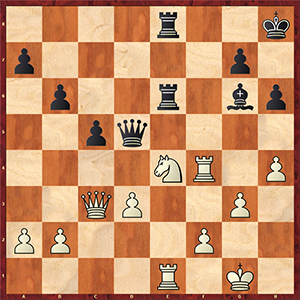
Fabiano has been retaining initiative for the most part of the game. His active play was crowned by his winning a pawn. After that, however, he became somewhat obsessed with the idea of keeping this pawn for himself, thus not preventing his opponent from placing his pieces ideally. An attempt to simplify the game during the time trouble resulted in a disaster.
36.Qb3??
36.a3 or 36.b3 would have allowed White to maintain rough equality.
36...c4!
It appears that 37.dxc4 is met by 37...Qa5! with a double attack on e1 and e4. The afterimage of the c5-pawn must have obstructed the Italian player’s advanced view of the sideway lunge of the black queen.
Therefore, he had to resign himself to losing the d3-pawn.
37.Qc3 cxd3
This was not the end of his problems, however...
38. f3 Bxe4 39.fxe4 Rxe4 40.Rexe4 Rxe4

41.Rf2?!
Upon considerable amount of contemplation White has made up his mind to take the path of least resistance. He should have double checked the option of transiting into a queen ending. After 41.Rxe4 Qxe4 42.Qd2 Qf3 43.Qf2 Black would need to be on the constant alert for perpetual check possibilities. But the win is there, or course: 43...Qg4 (43...Qd5!? 44.Qd2 Qxa2 45.Qxd3 Qa1+ 46.Kf2 Qxb2+ would be another practical approach to this position) 44.Kg2 (44.Qe3 d2) 44...Qe4+ 45.Qf3 Qc4 46.Qf8+ Kh7 47.Qf5+ Kg8 48.b3 Qc6+ 49.Kh2 Qd6 (49...d2? 50.Qd3=) 50.Qc8+ Kh7 51.Qf5+ g6 52.Qe4 d2 53.Qb7+ Kg8 54.Qc8+ Kf7 55.Qb7+ Kf6 56.Qf3+ Ke7 57.Qb7+ Kd8 58.Qa8+ Kc7! 59.Qxa7+ Kc6 60.Qa4+ (60.Qa8+ Kc5 61.Qa3+ Kd5–+) 60...Kb7 61.Qe4+ Kb8 62.Qe8+ Kc7 63.Qf7+ Qd7 64.Qf4+ Kc8 65.Qc4+ Kb7 66.Qe4+ Ka7 when White has finally run out of checks and the pawn cannot be stopped from promoting.
There may be some shortcut to an easier win but it still needs to be discovered over the board. This is not the easiest of tasks for a weary warrior.
41...Re3
The weakness of the white king aggravates even further the utter helplessness of his having to struggle against the far-advanced black pawn.
42.Kh2 Qe4 (42...Kh7!) 43.Qc8+ Kh7 44.Rf4
White would also stand no chances of survival after 44.Qf5+ Qxf5 45.Rxf5 Re2+ 46.Kh3 Rxb2 47.Rd5 Rxa2–+.
44...Re2+ 45.Kh3 Qg2+ 46.Kg4 h5+! 47.Kxh5 Qxg3
White resigns in view of the inevitable mate.
The field of pursuers has not succeeded in escaping casualties.
Grischuk – Karjakin
The giant of chess, who has remained dormant during the first half the event, has finally woken up. Being faced off with one's principal rival is the best reason to rise up to the occasion.
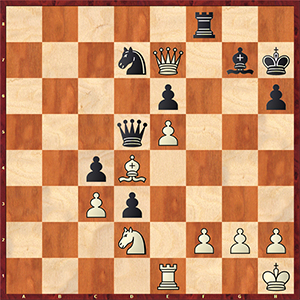
White is up a pawn, keeping initiative. However, he is being pulled down heavily by the d3-pawn, which feeds Black with substantial counterplay in all lines.
34...Rf5
The knight transfer to c6 via 34...Nb8! is even stronger.
35.Re3
While the engine insists on 35.Nf1 Rf4 36.Ne3 Qc6 37.f3, any human player is more than likely to feel intimidated by the exchange sacrifice 37...Rxd4 38.cxd4 c3. Being in time trouble, this is a sure failure for anyone to prevent such pawns from promoting. It is only in the analysis that these pawns can be neutralized: 39.Qb4 Nb6 40.Rc1 Na4 41.Qb3 Bf8 42.Nc4 Be7 43.Rd1 Qd5 44.Rxd3 Nc5 45.Qxc3 Nxd3 46.Qxd3+ is winning for White.
35...Rg5 36.Rg3 Nxe5
While being quite a logical move, it fails from the practical point of view. The d4-bishop has now joined in on the attack against the black king.
A lot simpler is 36...Rxg3 37.hxg3 Nb8!, for example, 38.Be3 Nc6 39.Qc7 Nxe5 40.Bd4 Kg6 41.f3 (41.g4 Nf7) 41...h5 (41...Nf7 42.Bxg7 Kxg7 43.Qxc4) 42.Kh2 Bf6 with no more than a slight advantage for White.
Karjakin must have either missed the Nd7-b8-c6 idea entirely or believed the e5-pawn capture to be a must.
37.Rxg5 hxg5 38.Nxc4
This logical desire to do away with the e5-knight has provided Black with unexpected counter chances.
Such lines as 38. h4! were too complex to calculate while in time trouble, for example 38...g4 (38...gxh4 39.Nf3! d2 40.Qxh4+ Kg8 41.Nxd2 Ng6 42.Qg4±) 39.Kh2 Kg8 40.Kg3! Nf7 41.Qe8+ Bf8 42.Bf6 Qf5 (42...Qd6+ 43.Kxg4 e5 44.Bg5 Qg6 45.Kg3 Kg7 46.Nxc4+-) 43.Be7 Qe5+ 44.f4 gxf3+ 45.Kh3! Qg7 46.gxf3 Nh6 47.Bxf8 Qxf8 48.Qxe6+ Kg7 49.Qxc4+–.
38...Kg6!
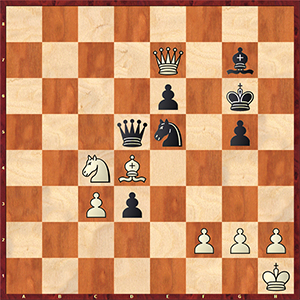
It appears that Black has fear neither of checks nor of piece trading as his trump is ready to go all the way down from d3 to d1.
39.Qe8+
Sergei had more than four minutes on his clock at that moment, which is indeed a wealth of time! He could have used this time for unhasty thinking and calculating. The precise 39...Kh6 would have left White with no real chances of success. For example, 40.Ne3 d2! 41.h3 Qb3 42.Kh2 d1Q 43.Nxd1 Qxd1 44.Qxe6+ Ng6 with equality.
However, either out of sheer inertia, or due to insignificant amount of time on the clock of his opponent (about half a minute) Karjakin almost instantly banged out with 39...Nf7?? and received 40.Qg8! in response.
He had to resign immediately because 40...e5 is met by 41.Nxe5+.
This is how Sergei rolled back from one of the leading positions and has imperiled his chances to qualify. On the other hand, those players who have up to recently been ending all their games in draws started to lunge forward.
Jobava - Nakamura
This game saw the rivals sporting with deliberately fast and surprisingly unpredictable actions in front of each other. The spectacular and brave cavalry-like performance by Baadur led him into a difficult ending, in which he was defending no less than heroically and almost managed to survive in a position where survival was just impossible.

White is in bad shape. However, “the Guard dies, but does not surrender “.
44.f5!
Starting from now Hikaru has missed more than one opportunity to bring the point home (I am going to refrain from bringing forth all the missed opportunities) and has finally ended up in an equal position.
44...exf5
Simpler was 44...dxe4! 45.fxe6 (45.dxe4 gxf5 46.exf5 Nge2–+) 45...e3 46.Ne4 Nf3+ 47.Kd1 e2+ and Black is winning.
45.exd5 Nge2 46.Rc8 Rxd3 47.Nc4 Rxh3 48.Ne5 Nf3+ 49.Nxf3 Nf4 50.Kf2 Nxd5
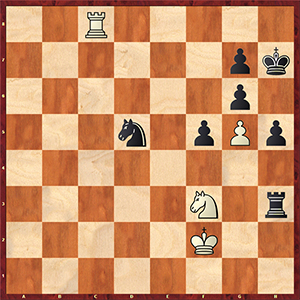
When commenting online we began to suspect this position to contain some study-like ideas. Black king is completely isolated from the rest of the world. After 51.Rb8 Nf4 52.Ne5 Nd3+ 53.Kg2 Nxe5 54.Kxh3 Nf3 55.Kg3 Nxg5 56.Kf4 Ne6+ 57.Ke5 Nc5 58.Kf4 there appeared a curious position where Black cannot avoid losing material if he wants to make any progress at all. Still, four pawns is just too much a material. The path to victory has been finally discovered: 58...h4 59.Ra8 (59.Kg5 Ne4+ 60.Kxh4 g5+ 61.Kh3 g4+ 62.Kh4 g5+ 63.Kh5 g3–+) 59...Ne6+ 60.Ke5 Ng5 61.Kf4 Nh3+ 62.Ke5 Kh6!.
Baadur has made up his mind to dispense with exchanges.
51.Ne5 Rc3 52.Rd8
White continues to threaten mate after Ne5-f7.
52...Ne7 53.Rd7 Rc2+ 54.Kg3 f4+
Giving back the looted valuables was not mandatory. The goal could have been attained by 54...Nc6 55.Rc7 Nd4, for example 56.Rxc2 Nxc2 57.Nd7 Nb4 58.Kf2 Nc6 59.Nf8+ Kg8 60.Nxg6 Kf7 61.Nh4 f4!? 62.Kf3 Ne5+ 63.Kxf4 Ng6+ and Black is winning.
55. Kxf4 Nf5 56.Rd8 Rf2+ 57.Ke4 Ng3+ 58.Kd3 h4?!
This is a hasty move. The advantage could have been converted via 58...Rf1! 59.Nd7 h4 60.Nf8+ Kg8 61.Nxg6+ Kf7 62.Ne5+ (62.Nxh4 Rd1+) 62...Ke6 63.Re8+ Kf5.
59. Rd4 Nf5 60.Rd8 Ng3 61.Rd4 Rf5 62.Rxh4+ Nh5 63.Ke4 Rxg5
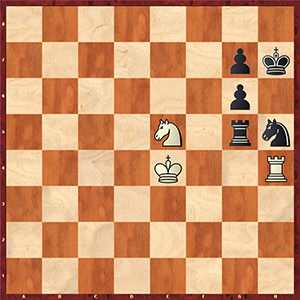
Being up two pawns is a good starting point for future victory. However, Black goes on experiencing difficulties in bringing his king into the game. Having sacrificed another pawn he stands the risk of finding himself in a theoretically drawish endgame.
64.Kd5 Rg1 65.Ke6?!
Not here, the other way around! Too active position of White’s king ends up in his disaster.
The king should have been kept in the center by 65.Kd4! Now, the white king is in time to return home should the game happen to transit into the rook ending: 65...Kh6 66.Nf7+ Kh7 67.Ne5 Kg8 68.Nxg6 Rxg6 69.Rxh5=.
During my initial analysis I failed to come up with any winning continuations for Black: 65...Rd1+ 66.Ke3 Re1+ 67.Kd4 Rf1 (67...Rg1 68.Ke3) 68.Rg4 Rf4+ 69.Rxf4 Nxf4 70.Ke4 Ne6 (or 70...g5 71.Kf5 Kh6 72.Nf7+ Kh5 73.Nxg5=) 71.Nf7!
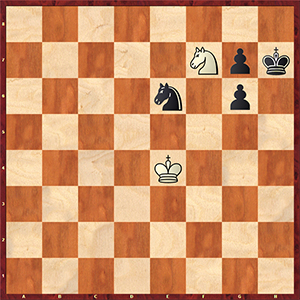
What a spectacular draw! Had Black had time to carry out g6-g5 and Kh7-g6 he would have transited into a theoretically winning position that can be looked up in the Nalimov’s tablebases, the point being that Black is not in time to activate his pieces decisively: 71...Kg8 (71...g5 72.Kf5!; 71...Nf8 72.Kf4!) 72.Ne5 Kh7 73.Nf7=.
65...Rf1 66.Rh2 Rf6+
It was not yet too late to start to act sensibly: 67.Kd5 Rf8 68.Ke6 Rf1 (68...Kh6 69.Nf7+) 69.Rh4 Re1 70.Kd5 etc. However, once he started drifting away, he couldn’t help himself any longer...
67. Ke7? Kg8!
Now Black is entitled to sacrifice yet another pawn.
68.Nxg6
Otherwise Black would have gradually untangled via Nh5-f4, g6-g5 etc.
68...Rxg6 69.Rxh5

With White’s king cut off along the rank the method of winning is not that complicated.
69...Ra6 70.Rf5 g6 71.Rf6 Ra7+ 72.Ke6 Kg7 73.Rf3 Ra5 74.Rf7+ Kh6 75.Rf1 g5 76.Kf6 Ra4! 77.Rh1+ Rh4 78.Rg1 Rf4+ 79.Ke5 Kg6 80.Rh1 Ra4 White resigns.
The highlight of the round came in the form of the eldest player winning his first game in this tournament, an especially noteworthy event if we also take into consideration his streak of 16 draws in a row (together with his other games from the World Team Championship). At last, his seventeenth attempt ended in a triumph.
Gelfand – Svidler
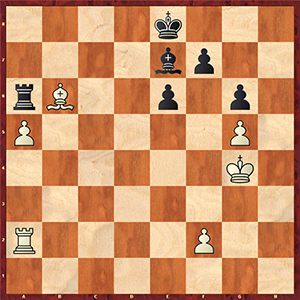
Black is in a plight, but he is not without resources yet. Paradoxically, Boris owes his success to his own time trouble... He left only 20 seconds for himself for the remaining four moves until the end of next time control. This fact must have prompted Peter into "decisive" actions.
56...f5+?
This is a step in the wrong direction as the exchange of pawns clearly favors White. The g5-pawn used to be a weakness that would restrict the white king from becoming actively engaged in the endgame.
Black should have maneuvered with his king for a while in order to avoid committing himself to any committal decisions just yet. He could have carried out the f7-f5 advance under more favorable circumstances. For example: 56...Kd7 57.Rd2+ Kc6 58.Rc2+ Kd7 59.Rc7+ Kd6.
Now in response to 60.f4 Black can already start contemplating about 60...f5+!?, but a lot simpler would be to transit into the rook ending via: 60...Bd8! 61.Rxf7 (61.Rb7 should be definitely answered with 61...f5+!) 61...Bxb6 62.axb6 Rxb6 63.Rg7 Rb4 64.Rxg6 Ke7 and we have reached a theoretically drawn position.
White’s further maneuvering will entitle Black to start altering his pawn structure: 60.Rc4 e5!? 61.Rc7 Ra8 62.Rb7 Ra6.
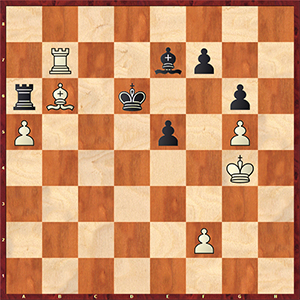
White king is still confined to defending the g5-pawn. If Black sticks to repeating the moves via Ra6-a8-a6 it is not clear how White is going to achieve any progress at all.
In the gameWhite’s task became much easier once he was relieved of having to defend the g5-pawn.
57.gxf6 Bxf6 58.Kf4
White king, being now as free as the wind, is heading for b5.
58...Kd7 59.Ke4 Bc3?
This is another hasty move in the time trouble that is leading Black nowhere. He should have established close contact with White’s passed pawn as soon as possible: 59...Kc6!? 60.Rc2+ Kb5

In this case White would have faced definite technical problems converting his advantage. The straightforward play could have ended up in disappointment: 61.Rc5+ Ka4 62.Rc6 Kb5 63.Rxe6 Bc3 64.Kd5 (64.Rxg6 Bxa5=) 64...g5 65.f3 Bxa5 66.Bxa5 (66.Be3 Rxe6 67.Kxe6 Kc4 68.Bxg5 Kd3=) 66...Rxa5 67.Re5 Kb6+ 68.Ke6 Ra3 69.Rf5 Kc6 70.Kf6 Kd6 71.Kxg5 Ke6 reaching a drawn position!
Therefore, some subtle maneuvering was required, where one possible path was, for example, as follows: 61.f4!? Ra8 62.Rc5+ Ka4 (or 62...Ka6 63.Rc6 Re8 64.Bd8+ Kb5 65.Rb6+ Kxa5 66.Rxe6+ Rxd8 67.Rxf6 Rg8 68.Kf3 g5 69.f5+-) 63.Rc6 Ra6 64.Rxe6 Bc3! 65.Kd5! Kb5 (65...Bd2 66.Re2!) 66.Re3! Bxa5 67.Bxa5 Rxa5 68.Re6 Kb4+ 69.Ke4 g5 70.f5! and Black fails due to his king being misplaced.
The game, however, saw a more prosaic finish.
60.Kd3! Bf6 61.Kc4 Kc6 62.Rc2! Black resigns.
White threatens with Kc4-b4-b5. 62...Be7 fails to help the situation in view of 63.Re2 Kd7 64.Kb5 etc.
The winner of the previous Grand Prix is kept being haunted by bad luck. Having obtained virtually won position right from the opening, he failed to convert this advantage to a full point. To my mind, the GM from Saratov has once again been let down by his “being low on batteries”.
Tomashevsky - Dominguez
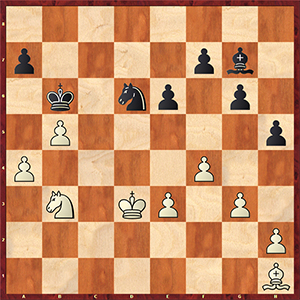
Black has set up a solid line of defense. The position features the opposite-colored bishops, the fact which markedly enhances the drawish potential of the game. Following the period of extensive preparations Evgeny has finally made up his mind to launch an offensive.
41.Bc6
I analyzed White’s plan connected with advancing his pawn to as far as g5. For example, 41.h3 Bf6 42.Bf3 Bg7 43.g4 hxg4 44.hxg4 Bb2 45.g5 to be followed up with the same as in the game idea of placing his bishop on c6. Despite the exchange of a pair of pawns, the chances of winning are still there as the g5-pawn fixes Black’s weaknesses on the kingside. I have so far failed to find out a clear plan for Black to escape. However, I am not going to be surprised if such plan is found out after all...
41...a6 42.Nd2!
42.a5+ is useless in view of Kc7.
42...axb5 43.axb5?!
It appears to be an unsuccessful decision. Strangely enough, during our online broadcasting with Sergey Rublevsky we were also entirely absorbed by analyzing this continuation. However, 43.Bxb5! would leave White with reasonable winning chances. In this case Black could hardly leave White with the passed a4-pawn because the exchange of knights would afford White a relatively easy victory. After 43...Nxb5 44.Nc4+ Kc5 45.axb5

45...Kxb5 is losing in view of 46.Nd6+ Kc6 47.Nxf7 Kd5 (47...Kd7 48.Ke4 Ke7 49.Ne5 Kf6 50.h4 Bh8 51.Kd3 Bg7 52.e4 Bh8 53.Kc4+-) 48.e4+ Kc5 49.Ke3 Bd4+ 50.Kf3 Bf6 51.h4! – the knight will land either on e5 or g5 and the resulting pawn ending is won for White.
The prophylactic moves of the f7-pawn were subjected to analysis as well. In all likelihood they failed to warrant any escape chances either. Let’s take a look at the following lines: 45 ... f5 46.b6 Kc6 47.e4 Bf6 48.h4 Bg7 49.Ke3 Bc3 (49 ... Bf6 50.Ne5 Kxb6 51.Nd7) 50.Ne5 Kxb6 51.Nxg6 fxe4 (or 51...Be1 52.exf5 exf5 53.Kd4 -; 51 ... Kc7 52.exf5 exf5 53.Ne7 -) 52.Kxe4 Kc6 (52 ... Be1 53.Ke5) 53.f5! Kd6 54.Nf4, and two pawns plus the knight prevail over the bishop.
Let’s also take a look at the line with 45...f6 46.b6 Kc6 47.e4 Bf8 48.e5! f5 49.Nd6 Kxb6 50.Nf7 Kc6 51.Nh8 Bc5 52.Nxg6

White has a simple winning plan. He puts his knight on f3 (creating permanent threats of knight’s landing on g5) and brings his king via g2 and h3 to h4. At a suitable moment the knight is going to land on g5 via Nf3-g5 to interfere with the bishop and to clear the way for the king, whereas the exchange of minor pieces on g5 would end up in a won ending for White. Otherwise Black is just going to lose his h5-pawn.
The current verdict is that after 43.Bxb5 White was winning.
43...Nxb5 44.Be8
During the post-game analysis the opponents spent a lot of time analyzing the consequences of the 44.Bxb5 Kxb5 45.Nf3 line. It appears that there is no more winning in this position: 45...Bf6 46.Ke4 (46.Ng5 Bxg5 47.fxg5 Kc5 48.Ke4 Kd6 49.Kd4 Kd7 50.Ke5 Ke7 51.h3 Kd7 52.Kf6 Ke8=) 46...Bg7 47.Ng5 (or 47.Ne5 f5+ 48.Kf3 g5=) 47...f5+ 48.Kf3 (48.Kd3 e5 49.fxe5 Bxe5 50.Nf3 Bf6=) 48...e5 49.fxe5 (49.e4 Kc4!) 49...Bxe5
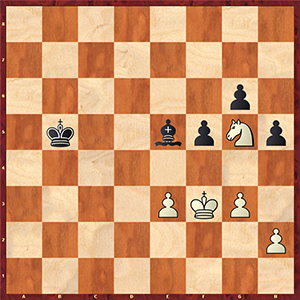
50.Nf7 (or 50.Ne6 Kc4 51.Nf4 Bxf4 52.Kxf4 Kd3=) 50...Bc3 51.Kf4 Kc4! 52.Ne5+ (52.Kg5 Kd3 53.Kxg6 Kxe3 54.Kxh5 f4=) 52...Bxe5+ 53.Kxe5 Kd3=.
44...Nd6 45.Nc4+ Kc7 46.Nxd6 Kxd6 47.Bxf7
White managed to penetrate Black’s forces on the kingside to cash in on two pawns at one go, however...
47...h4! 48.Bxg6
Fruitless is 48.g4 g5 49.fxg5 Ke7 50.Bg8 Be5 51.h3 Bb2=.
48...hxg3 49.hxg3

Although the resulting position is drawish, Black needs to be on the constant alert so as to be able to immediately meet e3-e4 with e6-e5! In the subsequent part of the game Evgeny tried hard to pry Black’s position open, but Leinier’ defensive performance was impeccable.
49...Bb2 50.Ke4 Ke7 51.Bh5 Kf6 52.g4 (52.Kf3 e5 53.Ke4 exf4 54.gxf4 Ba3 55.Kf3 Bc5 56.e4 Bd6=) 52...Ke7 53.Kf3 Bc1! 54.Bg6 (54.e4 e5=) 54...Bd2 55.Bc2 Kf6 56.Bd3 Bc1 57.Bb1 Bd2 58.Be4 Bc1 59.Bc2 Bd2 60.Bd3 Bc1 61.Bb5 Bd2 62.Bd7 Ke7 63.Bc8 Kf6 64.Ba6 Bc1 65.Bc4 Bd2 66.Bb3 Bc1 67.Ba2 Bd2 68.Bc4 Bc1 69.g5+ Ke7 70.Ke2 Ba3 71.Bb3 Bc1 72.Kd3 Ba3 73.Kd2 Bb4+ 74.Ke2

74...Ba3!
Black is just one step away from the sudden death: 74...Bc5?? 75.e4 Ba3 (75...e5 76.f5+-) 76.e5 Bc1 77.Kf3 Bd2 78.g6 etc.
75.Kd3
75.e4 Bc1 76.Kf3 e5=
75...Bc1 76.Bd1 Kf7 77.Bh5+ Ke7 78.Ke2 Kf8 79.Kf3 Bd2 80.Ke4 Bc1 81.Kd4 Bb2+ 82.Kd3 Bc1 83.Ke2 Kg7 84.Kf3 Bd2 85.Bg4 Kf7 86.Bh3 Bc1 87.Bxe6+!
This is White’s last hope.
87...Kxe6 88.e4

88...Bd2 89.Kg4 Bc1 90.Kg3 Bd2 91.Kf3 Bc1 92.Kg4 Bd2 93.f5+
In the case of 93.e5 the only way to escape is 93...Bb4! 94. g6 Bf8.
93...Ke5 94.Kh5
or 94.g6 Bh6! (94...Kf6? 95.e5+) 95.Kh5 Bg7 96.Kg5 Bf6+ 97.Kh6 Kxe4=
94...Kxe4 95.g6 Bc3 96.Kg5 Kd5 97.Kh6 Ke4! 98.Kg5 Kd5 99.f6 Ke6 100.g7 Bxf6+ 101.Kg6 Draw.
This stage of the tournament sees the triumvirate of Caruana, Nakamura and Dominguez who are half a point ahead of Gelfand, Karjakin and Jakovenko.
So far Caruana and Nakamura have broken even further away from the rest of the field in the overall Grand Prix standings.
However, with three rounds to go the balance of powers in the leading group can change anytime, especially with the pursuers following each other so closely.
Long live the day off! We will be back into the action tomorrow...






















